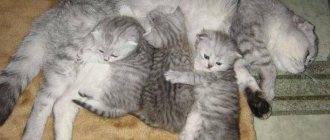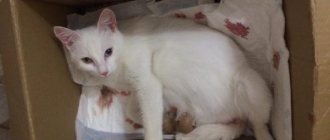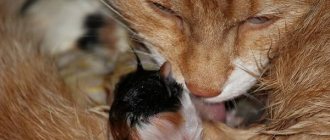Preparing a place for a cat to give birth, what you need to pack for the birth
If the cat becomes restless and hides, then it’s time to choose a place to give birth. She will definitely choose it herself, but these may be unacceptable, from the owner’s point of view, locations - for example, in a wardrobe or in a pencil case in the kitchen.
The owner of the cat needs to outline in advance a list of places in the apartment that are inaccessible for childbirth.
To choose the right place, they are guided by the instincts of the animal. The following requirements are imposed on the “maternity room”:
- privacy from prying eyes;
- absence of drafts, dampness and cold (recommended temperature is 29–30 °C);
- shading.
The room should be warm enough so that the kittens do not get sick.
Dishes with drink and food are placed not far from the chosen place, since the mother in labor will not be able to leave the offspring for a long time.
Another criterion by which a place for childbirth is looked for is accessibility for a person. After all, the process does not always proceed without problems; sometimes animals require the help of the owner or even a veterinarian.
The bedroom is one of the most suitable places in the house for a giving birth cat.
Experienced breeders advise: all corners where it is impossible for a person to penetrate in order to control the process are blocked. The optimal place that cats prefer in the house is the bedroom.
If there are other animals in the home, exclude their access to the offspring for the next few weeks after birth. In addition, contact with them increases the risk of the spread of bacterial and viral infections, which can lead to the death of the offspring and the woman in labor, whose body is extremely weakened during this period. Remove cosmetics and household chemicals to prevent poisoning.
Delivery box
The simplest option for a “maternity hospital” is a large cardboard box with sides no less than 60 cm. After all, a cat and her litter will spend at least a month here. If the space is crowded, kittens may get injured.
When choosing a cardboard box, don’t settle for compact models - kittens need space
The box must include:
- a removable lid to allow access to residents when assistance is needed and to the contents for cleaning;
- an entry hole at the level of the cat’s chest - this will make it easier for the female to get inside, but will not allow small kittens to crawl out;
- you can make several “outbuildings” - a dining room and a toilet, where you can place food and a tray with filler.
In a cramped box, a cat runs the risk of miscalculating her efforts and accidentally crushing the kittens.
The top of the box is reinforced with tape, covering the joints. Decorating the building is not recommended. The products that are used - paints, varnishes, polymer materials - can scare away the cat with the smell.
Drawing of a cardboard house for giving birth to a cat
The fact that childbirth is approaching will be warned by the release of the mucus plug, which covered the entrance to the uterus during the entire period of gestation.
If you do not plan to sterilize the cat, then it is better to acquire more reliable structures - for example, made of plywood, or exhibition tents.
Plywood birthing houses are well suited for large breeds.
Some breeders recommend preparing not one, but two houses at once. In the second, newborn kittens are placed until the female reproduces all the offspring. Then the babies are transferred to their mother.
Heating
The place where newborn kittens will be located for the first weeks of life must have a constant temperature. Temperature changes can adversely affect the health of kittens and weaken the immune system.
Hypothermia or overheating of newborns is unacceptable
You need to wrap it tightly in a towel, take it firmly in your palm so that the head and body are well fixed, and shake it several times gently but quite sharply, like a thermometer, lowering the kitten head down. This is necessary for the liquid to come out of the nose and throat. If necessary, place a cloth or gauze on the kitten's face and suck out the liquid from the nose with your mouth.
- break the bubble with your fingers, moving from the chin to the back of the head
- wipe the kitten’s face, taking it with a napkin, as if in a pinch, moving from the forehead to the tip of the nose, using a syringe, remove mucus from the nose and mouth if necessary
We suggest you read: Pyoderma in cats, diagnosis, treatment and possible complications
- cut the umbilical cord, to do this: pinch the umbilical cord near the kitten’s body with your fingers, and with the fingers of the other hand squeeze the contents of the umbilical cord towards the afterbirth at a distance of 5-7 cm. Carefully, do not pull, so as not to provoke a hernia. Next, you need to cut the umbilical cord with disinfected scissors at a distance of 3-4 cm from the baby’s body.
- let the cat eat the afterbirth from the first kitten, this stimulates labor (but no more than 2-3 afterbirths, the cat may have diarrhea)
- rub the kitten intensively but gently with a terry towel (this stimulates blood circulation)
- place it on the mother cat and make sure the baby latch onto it
All. All kittens were born. God bless!
Now you need to change the bedding to a new one, preferably white (this way you can control the cat’s discharge). It must be changed at least once a day.
If you have enough strength, weigh each baby on a kitchen scale, make a chart and write down the weight. Newborn kittens weigh on average 60-100 grams. Kittens weighing less than 60 grams are often not viable.
Check to see if all the kittens are latched and that they are all sucking milk normally.
Praise your cat mom and promise her that you will help her raise her healthy and the most beautiful British kittens in the world!
Each cat tries to choose the place for birth itself. Usually this is a secluded, quiet corner: a drawer with clothes, linen closets, a drawer in the sofa. In an ordinary apartment, this is extremely inconvenient, unhygienic and can be dangerous for newborn kittens.
Why is it advisable to isolate a cat during childbirth and feeding babies?
I often see cries for help online when people can't find hidden kittens. Sometimes babies die by suffocating in underwear or clothes, crushed by the mechanism of the sofa. At night, if the cat suddenly pulls the kitten out of the box, you can accidentally step on it. During childbirth and several days after it, the cat has quite a lot of discharge. It’s better to control the process so that you don’t feel sad over hopelessly damaged things.
Where does a cat give birth?
The place for giving birth and feeding newborn kittens should be in a quiet place, protected from direct light, drafts, and the annoying curiosity of owners and other animals.
Cardboard box. In this case, it is difficult to control that the cat does not drag the kittens.
You can put baby or disposable diapers at the bottom of such a box and change them regularly so that the nest is always clean. You can also put bottles or hot water bottles in the box to keep the nest warm. A cardboard box usually does not have enough space for a tray and bowls of food and water. Cage.
There is not enough privacy, it is difficult to keep warm, and it is not convenient to give birth. Cages are rarely used by owners of a small number of cats. Birthing box. Typically, these boxes have a hinged lid on the top and have a cat entrance located so that small kittens cannot use it.
The boxes rarely have enough space for a tray and bowls; they are designed to be placed in a special enclosure or a separate room. Cube tent. They come in different sizes. It is convenient to store and wash. It closes easily, which prevents the cat from dragging the kittens around the apartment. It is convenient to give birth in it.
Inconvenient to assemble. Filling, food debris, water and other liquids leak under the frame tubes. Washing and cleaning all this stuff is somewhat problematic. The durability of such a tent depends on the materials used; in practice, they quickly lose their “sales appearance.” Arched tent. They come in different sizes.
How to prepare a comfortable place for a cat to give birth?
For the birth and feeding of newborn kittens, my Balinese nursery uses a double exhibition tent, Sturdi Show Shelter Double Euro Back. The cat begins to “master” housing a couple of weeks before giving birth. This tent is in my bedroom, one part of it is completely hidden under the table, which provides plenty of cover.
We invite you to familiarize yourself with: Cats of the Napoleon breed: description, character, advice on maintenance and care, photos
In the “secret” part there is a soft mattress and a house; in the open part there is a vinyl tray, from which it is convenient to wipe up spilled water and remove spilled food and litter. There is a tray, a bowl of water and a bowl of food on it. To make the cat more willing to use the housing I offer, I give her all sorts of treats only in the tent.
During labor, I cover the floor of the tent with disposable diapers, which I throw away when they get dirty. When all the kittens have been born, in the far part of the tent, in addition to a mattress covered with a disposable diaper and a house, I put two 2-liter bottles of hot water, which I also wrap in disposable diapers. This way the kittens won’t get burned, the water won’t leak and will stay warm longer.
My cat really values the privacy of her room with the kittens, so while they are very tiny, I close the partition that is in the double tent completely at night and almost completely during the day. In this case, my Balinese cat is completely calm and does not try to hide the kittens. The proximity of the tray, water and food allows her to be with the kittens all the time.
Share the link with friends/Share it
The physiology of cats is such that in most cases childbirth is easy, without complications. However, you need to prepare for the birth of babies in advance. Provide your pet with a place to lie where she will feel safe. The place must be protected from drafts. The woman in labor should not be disturbed by children or other pets.
Medicines
Before the cat gives birth, it is necessary to prepare a number of medications necessary both to stimulate labor activity and for disinfection and antibacterial treatment of newborns.
To speed up labor
If labor is good, then medications are not needed. But in case of complications, on the recommendation of a doctor, veterinary medications can be used to stimulate the process.
Table 1. Drugs that accelerate cat labor
| A drug | Method of administration | Description |
Travmatin | Intramuscularly or subcutaneously 0.1 ml/kg animal weight or orally 5–15 drops | The drug activates the production of oxytocin, which increases uterine contractions. The manufacturer claims an analgesic, anti-shock, hemostatic, anti-inflammatory, and tissue regenerating effect. The product is recommended after any surgical interventions. It is also prescribed for large fetuses and large litter sizes, in case of severe bleeding |
Gamavit | Intravenously, intramuscularly or by drinking. The dose depends on the weight of the animal | A complex remedy that normalizes labor and cleanses the uterus of a dead fetus. In addition, the drug increases the survival rate of offspring |
Oxytocin | Subcutaneously, intramuscularly, intravenously. The dose is determined individually | Indicated for conditions such as atony and hypotension of the uterus, endometritis, uterine bleeding, weak labor, and retained placenta. Please note that the product is available in dosages of 5 and 10 units, so you need to calculate the dose for a cat manually |
Incorrect or unreasonable use of veterinary drugs can seriously harm the health of the mother in labor.
Another remedy that breeders talk about is a cocktail to induce labor. It is called the safest of the list. Prepare it yourself from the following components:
- glucose, sodium gluconate - 4 ml each;
- vitamin C - 2 ml.
The optimal place for subcutaneous injection of a “cocktail” to speed up labor is at the withers
Mix all components in a 10 ml syringe. For one injection, take 1 ml/5 kg of the cat’s weight. The mixture is administered subcutaneously after the birth of the first kitten.
The cocktail has a multifaceted effect:
- maintaining the uterus in tone;
- better yield of clots;
- nutrition;
- stimulation of milk production.
Before using medications to help your cat give birth, consult your veterinarian.
Before giving birth, it is recommended to discuss with your veterinarian the possibility of using all of the above remedies. Based on the animal’s condition, the specialist will choose the best drug and show where and how to inject.
You can also read about how to deliver a cat on our portal.
Video - How to inject the solution subcutaneously into a cat
Other drugs
In addition to the above drugs, the first aid kit for childbirth includes disinfectants - iodine or brilliant green. These drugs are used to treat the tip of the umbilical cord.
The umbilical cord is disinfected using iodine or brilliant green
You will also need:
- sterile petroleum jelly to facilitate the exit of the fetus from the birth canal;
- ammonia for resuscitation (the product is dripped onto cotton wool and brought to the kitten’s nose);
- glucose, saline solution (the first to lubricate the nipple, the second to lubricate the kitten’s mouth), drugs are used if the cub does not attach to the mother’s breast;
- chlorhexidine for hand disinfection.
How can you tell if your cat is going into labor?
At about 7-9 weeks of pregnancy, kittens actively move in their mother’s belly. When the animal is at rest, movements can be seen even from the side. Immediately before giving birth, the cat becomes restless. Breathing is rapid, appetite is reduced. The animal rushes about, looking for a secluded place.
There are other signs that labor is approaching:
- Rectal temperature is about 37 degrees 1-3 days before the birth of the offspring.
- Redness of the genitals.
- Swelling of the mammary glands. A few hours before giving birth, the cat periodically hunches over. This phenomenon is called training contractions.
- Decreased appetite (drinking regime remains the same).
If all of the listed signs are expressed, this is a signal that your pet will soon give birth.
Symptoms indicating the onset of labor:
- a few days before giving birth, the animal prepares a place for future offspring and can carry soft things and toys there;
- before contractions, the cat’s behavior changes sharply, it can meow loudly, rush from side to side, and refuses food;
- actively licks its fur, paying special attention to the intimate area, which is associated with the appearance of natural discharge before childbirth;
- During contractions, the cat’s condition noticeably worsens; she may fall to the floor, breathe heavily, and toss and turn.
If the owner determines that the pet is in critical condition, it is better to immediately take the woman in labor to the veterinary clinic. This measure will help eliminate the risks of complications and allow the cat to give birth to healthy kittens with the help of an experienced veterinarian.
The amniotic sac did not rupture
In this case, proceed in this order:
- Rip the amniotic sac under your baby's nose.
- Take the kitten in your palm, press it lightly with your fingers and shake it slightly. If there is no reaction, clean the newborn's nose using a syringe.
- Rub baby gently with a clean cloth and then shake again.
- Place the baby on the mother cat so she can lick him.
If the baby does not show signs of life, hold him (not by the paws!) upside down to stimulate breathing.
Basic Rules
When choosing a place where the cat will give birth and the kittens will spend the first weeks of their lives, it is important to adhere to the following rules:
- It should be warm and protected from drafts.
- Definitely safe and comfortable. It is very important to equip the maternity area where no one can accidentally step on the babies.
- Must be quiet and in a dark place.
- It is best to choose natural fabrics and materials.
- The design should be such as to enable the owner to do cleaning without disturbing the animals.
In this case, both the mustachioed mother and the kids will be comfortable. The place for childbirth should be prepared in advance, this will help accustom the animal to its new “house”.
The amniotic sac did not rupture
You can remove the kitten yourself:
- Put on medical gloves and lubricate the animal’s vagina with Vaseline oil.
- Take the kitten with a clean cloth and gently pull it down, rocking it slightly from side to side. You should not pull the paws.
What not to do:
- Pull the kitten out by the paws.
- Allow your cat to eat more than 2 placentas.
- Use antiseptics intended for humans.
- Hold newborns in your arms during the first hours.
- Turn on bright lights in the room. This leads to the development of cataracts in kittens.
Suitable options
In order for the animal to feel good and not worry too much, the birthing area should be properly prepared in a timely manner. Especially if the cat is pregnant for the first time, an inexperienced owner has to deliver the baby .
- A box for giving birth to a cat is the simplest and most convenient option. At the bottom you need to put something warm and soft, for example, an old sweater, and on it - disposable diapers that are easy to remove and change. Before giving birth, it is advisable to lay a fresh one.
- A cage is also a good option for the birth of kittens. When the kids grow up, it is very easy to wash.
- Box. You can place in it not only soft bedding, but also a feeder, a bowl of water, and if the size allows, even a tray. This way the cat can avoid being away from the babies for a long time.
- Baskets. They are equipped with special mattresses, which can later be washed without any problems. However, this is an open option, so the cat will not feel completely safe.
- Tents. For childbirth, you can also use tents - both exhibition and arched. They are easy to close, so the cat will not be able to constantly carry the kittens from place to place. However, an animal can spill water from a bowl or scatter food, and it is quite difficult to tidy up such a “house” while the kittens are in it.
- Breeders often use playpens as a place for childbirth.
The owner must first of all think about the pet, so it is better to refuse a fashionable and beautiful tent in advance if the animal previously felt uncomfortable in it.
Length of labor in a cat
There are 3 phases of labor in cats.
1 phase
In the first stage, the cervix weakens and uterine contractions begin. Contractions alternate with relaxations. The pelvic muscles are relaxed, the perineum is increased in size. Childbirth as such has not yet occurred, but if you put your hand on the pet’s belly, the movement of the kittens inside is clearly felt. The cat is restless, breathing heavily, running to the box and fussily rummaging through it. The duration of the first phase in first-born cats is up to 36 hours.
2 phase
It is characterized by painful and frequent contractions. The first kitten is about to be born. The amniotic sac is visible at the edge of the perineum. After it bursts, a little liquid flows out. At this stage, the cat is pushing, helping the kitten to be born. Duration of the second phase: 5-30 minutes.
We invite you to read: Wolf Spitz: features of the breed, characteristics of the Keeshond (photo)
3 phase
This stage occurs after all the kittens have been born. The placenta is born. As a rule, the amniotic membrane comes out along with the next kitten, sometimes there is a delay, and at the birth of the next baby, 2 membranes come out at once.
Possible complications during lambing
Complications during lambing can occur at any stage of birth in both mother and kittens.
Complications from the parturient side may be the following:
- ruptures of the birth canal due to hypertension;
- bleeding;
- refusal of kittens - the cat is not interested in newborns and growls if they are placed near her;
- sepsis;
- uterine prolapse;
- retention of placenta;
- acute mastitis – inflammation of the mammary glands;
- cannibalism.
We invite you to familiarize yourself with Chipmunk, a brief description for children in grade 4
Newborn problems:
- congenital malformations - cleft palate, development of internal organs outside the body;
- intrauterine infections, due to which kittens are stillborn or die in the first few days;
- abnormal position of the fetus - in such cases the cat will not be able to give birth on its own;
- aspiration (inhalation) of amniotic fluid, pneumonia.
Cleft palate in a kitten
How you can help:
- Before mating a cat, it is necessary to thoroughly examine her and the future father of the kittens for the presence of infections and pathologies that are transmitted genetically.
- During pregnancy, transfer the cat to specialized food for pregnant and lactating cats.
- Take an x-ray a week before the expected birth - this way you can accurately find out the number of kittens in order to understand when the birth should end. It is impossible to determine their number by ultrasound.
- Create the most sterile conditions for childbirth.
- Find “your” veterinarian and enlist his support.
A breed such as the Scottish has two variants of the phenotype - fold-eared and straight-eared. And it requires a special approach when breeding.
It is very important that only one of the parents has lop ears. If you cross two fold cats, then 100% of the kittens will be born with articular pathologies and will hardly live to be three years old. These will be disabled animals. This disease is called osteochondroplasia of Scottish fold cats and is associated with a mutation of cartilage tissue.
When should you contact a veterinarian?
You should immediately consult a doctor in the following cases:
- Premature birth (pregnancy less than 51 days).
- The cat has prolonged contractions, but the kitten is not born for more than an hour.
- The fruit is not positioned correctly (backwards) or is very large.
- The cat's body temperature is less than 37 or more than 39.5 degrees.
- Copious bloody discharge from the vulva with an extremely unpleasant odor.
- Heart rhythm disturbance.
- The cat is weakened, makes no attempts to expel the fetus, and her breathing is weak.
You should call your veterinarian if you don't know if everything is going well. It’s better to play it safe and bother the doctor than to waste time.
Sometimes labor stops for a while. The cat licks the kittens that have already been born, and the rest are born later. This is a variant of the norm if there are no visible signs of poor health.
»
- Thanks for the excellent instructions!!! You are well done
Comment from Vladimir - August 19, 2020 @ 19:42
- Good article
Comment from Nastya - March 4, 2020 @ 15:06
- Thanks for the article. My cat is pregnant for 22 days already. So sleepy! I prefer to make a nest from a cardboard box, ts
Comment from Ekaterina - April 22, 2020 @ 11:28
- It is easy for a cat to start dragging kittens from a cardboard box. This usually starts on the 3rd day after birth.
Comment from dizigner - May 2, 2020 @ 11:11
- I am delighted with how attentive you are to your beloved pet! Everything is deeply thought out down to the details. What a comfortable tent!!! SUPER! I really, really wanted the same one. I read your article several times during the day and looked at the photos. You are very inspiring! Thank you! We are expecting offspring the other day. The cat’s first birth.
Comment from Olga - June 5, 2020 @ 19:46
- I'm glad if my article helped you. My kittens now live in a two-room apartment + one-room apartment - it’s convenient
Comment from dizigner - July 15, 2020 @ 14:37
RSS feed of comments for this entry.
How to feed a cat after giving birth
In order for your cat to feel safe and not be nervous, you need to keep her and her offspring in a quiet room where children and other pets have no access. You should not touch kittens unless necessary. Moreover, children should not do this. The consequences are the most unpredictable. A mother cat often loses her milk from excitement.
After giving birth, the animal needs to regain strength and produce milk for the babies. The energy consumption of a cat who has given birth is many times greater than during pregnancy. The amount of food depends on the animal’s body weight, age and number of kittens born. Compared to the prenatal period, it doubles. It is necessary to increase the nutritional value of the diet.
From the first days after birth, the cat can be given meat. Be sure to include dairy products in your diet: yogurt, sour cream and cottage cheese. It is imperative to give milk, even if the cat has not drunk it before. However, milk should be introduced into the diet gradually, on the third day after birth, in small quantities.
If the cat reacts normally to milk (without stomach upset), you need to gradually increase the amount of product. A week after giving birth, the cat should be given milk every day. If the product causes diarrhea in your pet, use a dry product dissolved in water. With milk, the cat makes up for the deficiency of calcium, which is intensively washed out of the body with the birth of babies.
The source of calcium for a newborn cat is bone meal (about a teaspoon per day). Calcium preparations have a good effect: Marimix, Calcidelice.
In addition to meat and dairy products, the diet of a mother cat should include.
- Boiled fish.
- Boiled vegetables and herbs are a natural source of vitamins.
- Boiled eggs - chicken or quail.
If the cat is not accustomed to vegetables, they should be replaced with a vitamin complex (as prescribed by a veterinarian).
Equally important is compliance with the drinking regime. Access to water must be available 24 hours a day. In addition to water, the source of liquid for a cat is meat broths (chicken, beef, turkey) without spices and salt.
If your pet is accustomed to dry food, you should choose a special “dry” food or canned food for nursing cats. Special food for kittens is also not prohibited.
The bowl of food and water should be placed so that the cat can quench her hunger and thirst without leaving the babies for a long time. The frequency of feedings increases to 4-6 times a day, instead of the usual two times. Kittens suckle their mother intensively, so lactation should be continuous and plentiful.
A sign that the animal is eating properly is a silky, shiny coat. The cat does not lose weight, and the baby looks healthy and well-fed.
Maternity house: what is it?
A birthing box is a small home for a pregnant cat and her future kittens.
A special box that can be disassembled and assembled is installed indoors so that the cat can comfortably raise offspring. It is made from pet-safe material that is resistant to germs, infections, and does not absorb the smell of pet urine. Such a house is designed individually according to the owner’s requests or is sold ready-made. The birthing area has a door through which the animal can exit as needed, and sides to prevent kittens from getting out.
Hygiene
For 10 days after birth, the pet experiences discharge. This is a normal process of self-cleaning of the uterus, which, when contracting, pushes organic matter (lochia) out. At first, the lochia is brownish or red with green streaks. Gradually, the discharge becomes lighter, then completely colorless.
Clean by nature, the cat grooms itself, and the litter remains clean. But a weakened or primiparous animal must be helped by removing discharge from the inner thighs and vulva area with a moistened towel. It is also necessary to monitor the cleanliness of the litter.
Attempts by a cat to go outside should be resolutely stopped, as “gulena” will carry microorganisms on its paws that can harm the babies.
How to make a real cat house: ideas and life hacks
Each family member has their own favorite place in the house, where it is pleasant to sit and relax or read a book. And this applies not only to people, but also to pets. Our mustachioed friends choose different places to relax: some like to curl up in a warm blanket, while others like to climb onto the highest cabinet and watch their owners from there, half asleep.
We will share life hacks and advice from veterinarians on how to properly organize a cozy place for your pet.
The first thing to start with is choosing a location. Knowledge and observations of your mustachioed friend will help you choose the right one.
Veterinarians advise considering:
- character
- habits
- weight
- health status
- age of the cat.
For example, if your pet likes to climb into closets and sleep between things, a soft enclosed house will most likely suit him. A well-fed, castrated cat is unlikely to climb a high, unstable structure; it is best to make a house for him on the floor.
© Instagram @lizaveta_shaitura
After choosing a location, you need to determine what type of cat shelter will suit you.
There are cat houses:
- floor-mounted
- wall-mounted
- placed under the ceiling
- independent structures.
Now let's move on to choosing the material for the cat's place. And here it is absolutely not necessary to buy expensive special designs. You can easily make a house for your pet yourself from scrap materials and old things. Then the cat will not have to get used to the new smell.
We have made for you a selection of the most beautiful cat houses made from various materials, look and choose which one is right for you.
© Instagram @yarina_yara
Cardboard
The most common and affordable material for creating a shelter for your pet. All you need is a utility knife, tape and imagination. Don't forget to lay a soft blanket or pillow inside.
© Instagram @_benji_store_
Textile
Fabric beds, carefully sewn and stuffed with soft filling, are a wonderful option for heat-loving cats. To create such a cozy place, you can use any fabric and any filling.
© Instagram @elena_valdemarovna_tslv
It is used as a frame for a house, which is upholstered with soft foam rubber or other filling, and covered with fabric on top. Such a house can serve not only as a cat’s shelter, but also as a piece of furniture.
© Instagram @soft_seat
From this material you can make both a closed house and an open mini-sofa for a cat, it all depends on your desire.
© Instagram @murmodul
Rope, rope
Thick rope can be used to make a wonderful house for furry lovers to curl up and sleep sweetly.
© Instagram @kotognezdishko
It is also an important element for claw feet, which is used in any model of house. Rope is used to make scratching posts of various shapes and sizes.
©Instagram @kogteto4kin
Tree
Natural material with a characteristic smell will certainly be appreciated by your cat. It is upholstered with soft material and, of course, complemented with a scratching post.
© Instagram @kogtetochki_mint, @michaelsymba
Paper tubes
An excellent option for lovers of environmentally friendly materials. The house can be of any size, even two-story: below is a closed shelter, above is an observation post.
© Instagram @elenapozdeeva21
Rattan
A rattan wicker house can be closed or open, depending on your cat's habits. Add a soft pillow or blanket and your cat will be happy.
©Instagram @bbr_garden
Knitwear
A wonderful house will be made from knitted yarn. Your cat will be happy to relax in such a warm place. Any yarn will do, make the size suitable for your pet. He should not be cramped, but at the same time the boundaries should be noticeable.











